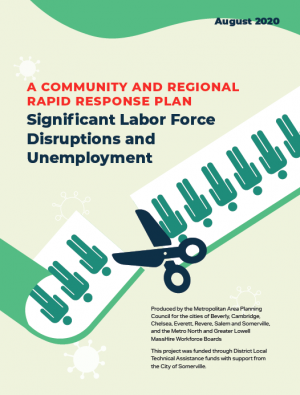COVID-19 Resources
Unemployment Response
Unemployment Response Plan
Where can municipalities get unemployment data? What systems should cities and towns have in place to assist their residents? How can municipalities work with career centers? If an official is contacted by an employer who's hiring, what should they do?
As COVID-19 causes layoffs throughout the state and country, municipalities are hearing from residents concerned about unemployment. Often, they don't have the data necessary to assess the problem at a local level. Many don't have a plan in place to respond to increased unemployment in the community.
Meanwhile, career centers and other local resources often have the information and resources that residents are looking for.
In August 2020, MAPC published a "Community and Regional Rapid Response Plan: Significant Labor Force Disruptions and Unemployment" for the cities of Beverly, Cambridge, Chelsea, Everett, Revere, Salem, and Somerville, and the Metro North and Greater Lowell MassHire Workforce Boards.
The report evaluates the immediate critical needs and options for unemployed individuals and creates an action framework for economic security.
This action framework is structured around the concept of a networked response, one that distributes actions across a range of actors to collectively leverage available resources and tools, to the short- and long-term recovery efforts.
More on COVID-19
- MAPC COVID-19 Resources
- COVID-19 Response Webinars
- Small Business Response Plans
- Research Brief: The COVID-19 Layoff Housing Gap
Questions?
MAPC stands ready to assist your community and the region during this time.
If you have questions or would like to work with MAPC on an unemployment response plan, contact Economic Development Manager Betsy Cowan at bcowan@mapc.org.
A Community and Regional Rapid Response Plan: Significant Labor Force Disruptions and Unemployment
The Coronavirus has drastically, and possibly permanently, altered traditional economic systems as we know them - in the MAPC region and across the globe. In partnership with organizations across the public, private, and nonprofit sectors, MAPC has worked to evaluate the immediate critical needs and options for unemployed individuals and to create an action framework for economic security. This action framework is structured around the concept of a networked response, one that distributes actions across a range of actors to collectively leverage available resources and tools, to the short- and long-term recovery efforts.

Unemployment Resources
MAPC is currently compiling a list of unemployment resources for our communities. As we learn more about additional programs, we will be sure to include them in this list.
If you have any additional resources, or have any questions, please do not hesitate to contact Betsy Cowan, Chief of Economic Development, at bcowan@mapc.org.
Unemployment benefits are currently available to workers who are unemployed through no fault of their own, ready and able to accept work, actively seeking work, and whose past income meets a minimum amount based on a 12-month base period. Expanded unemployment benefits are accessible under the federal Coronavirus Aid, Relief, and Economic Security (CARES) Act, and include the following in addition to state benefits:
- A weekly supplemental payment of $600 on top of any state-provided unemployment benefits until July 31, 2020.
- An additional 13 weeks of unemployment benefits, up to a maximum of 39 weeks, for people who have exhausted their state benefits.
- Unemployment benefits under the Pandemic Unemployment Assistance (PUA) program for independent contractors, gig workers, self-employed individuals, people with limited work histories, and others who may not normally qualify, including those who cannot work or who are partially unemployed due to being ill or quarantined as a result of coronavirus, caring for someone who has coronavirus, or caring for a child whose school is closed due to coronavirus.
- Reimbursement to states for the first week of unemployment benefits for individuals living in states where the first week is not normally covered.
- A requirement that states consider relaxing the “actively seeking work” requirement for those who have exhausted regular unemployment benefits if their ability to do so is affected by COVID-19.
Unemployment benefits for the Commonwealth of Massachusetts:
- Standard Benefit Amount: $98 - $823 per week (plus supplements for dependents)
- Maximum Duration/Amount of Benefits: 30 weeks (26 weeks when unemployment is low)
- Waiting Period: 1 week (waived for workers affected by COVID-19)
- State Benefits Related to Coronavirus: Benefits are available to people who have been quarantined due to COVID-19, regardless of whether they are scheduled to return to the same job after the quarantine. Benefits may be available to employees who leave their jobs due to a reasonable fear of exposure to coronavirus. Partial benefits may be available to employees who are working reduced hours due to COVID-19. The work search requirement is not waived except for employees who are scheduled to return to the same job after a quarantine, who must also remain in reasonable contact with the employer.
